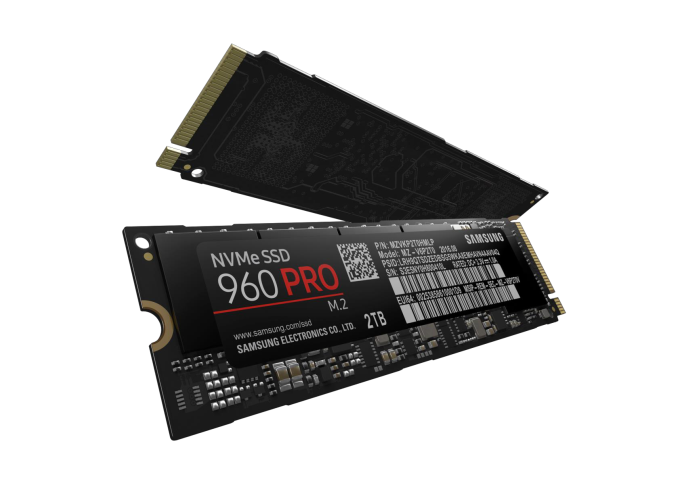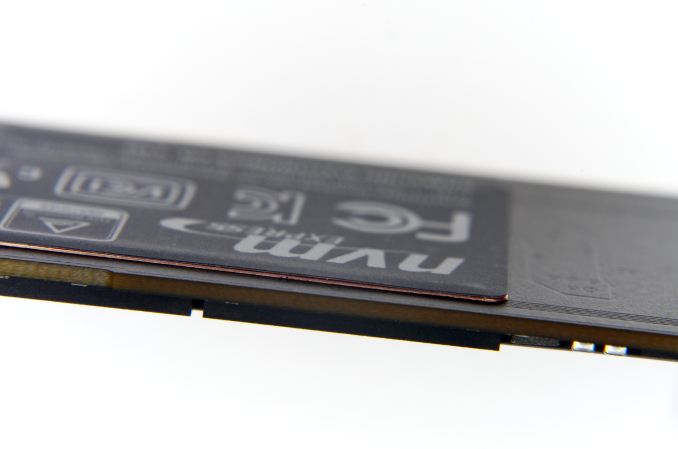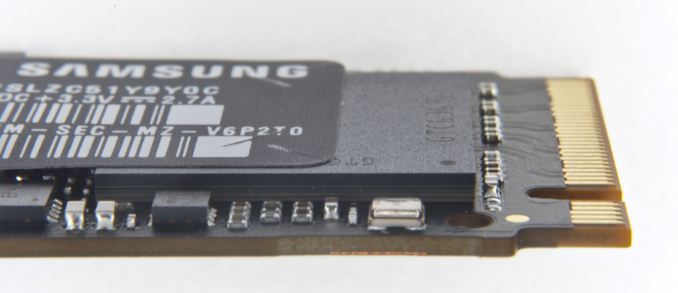The Samsung 960 Pro (2TB) SSD Review
by Billy Tallis on October 18, 2016 10:00 AM EST
A year ago, Samsung brought their PCIe SSD technology to the retail market in the form of the Samsung 950 Pro, an NVMe M.2 SSD with Samsung's 3D V-NAND flash memory. The 950 Pro didn't appear out of nowhere—Samsung had shipped two generations of M.2 PCIe SSDs to OEMs, but before the 950 Pro they hadn't targeted consumers directly.
Now, the successor to the 950 Pro is about to hit the market. The Samsung 960 Pro is from one perspective just a generational refresh of the 950 Pro: the 32-layer V-NAND is replaced with 48-layer V-NAND that has twice the capacity per die, and the UBX SSD controller is replaced by its Polaris successor that debuted earlier this year in the SM961 and PM961 OEM SSDs. However...
| Samsung 960 PRO Specifications Comparison | ||||||
| 960 PRO 2TB | 960 PRO 1TB | 960 PRO 512GB | 950 PRO 512GB |
950 PRO 256GB |
||
| Form Factor | Single-sided M.2 2280 | Single-sided M.2 2280 | ||||
| Controller | Samsung Polaris | Samsung UBX | ||||
| Interface | PCIe 3.0 x4 | PCIe 3.0 x4 | ||||
| NAND | Samsung 48-layer 256Gb MLC V-NAND | Samsung 32-layer 128Gbit MLC V-NAND | ||||
| Sequential Read | 3500 MB/s | 3500 MB/s | 3500 MB/s | 2500MB/s | 2200MB/s | |
| Sequential Write | 2100 MB/s | 2100 MB/s | 2100 MB/s | 1500MB/s | 900MB/s | |
| 4kB Random Read (QD1) | 14k IOPS | 12k IOPS | 11k IOPS | |||
| 4kB Random Write (QD1) | 50k IOPS | 43k IOPS | 43k IOPS | |||
| 4kB Random Read (QD32) | 440k IOPS | 440k IOPS | 330k IOPS | 300k IOPS | 270k IOPS | |
| 4kB Random Write (QD32) | 360k IOPS | 360k IOPS | 330k IOPS | 110k IOPS | 85k IOPS | |
| Read Power | 5.8W | 5.3W | 5.1W | 5.7W (average) | 5.1W (average) | |
| Write Power | 5.0W | 5.2W | 4.7W | |||
| Endurance | 1200TB | 800TB | 400TB | 400TB | 200TB | |
| Warranty | 5 Year | 5 Year | ||||
| Launch MSRP | $1299 | $629 | $329 | $350 | $200 | |
... looking at the performance specifications of the 960 Pro, it clearly is much more than just a refresh. Part of this is due to the fact that PCIe SSDs simply have more room to advance than SATA SSDs, so it's possible for Samsung to add 1GB/s to the sequential read speed and to triple the random write speed. But to bring about those improvements and stay at the top of a market segment that is seeing new competition every month, Samsung has had to make significant changes to almost every aspect of the hardware.
We've already analyzed Samsung's 48-layer V-NAND in reviewing the 4TB 850 EVO it first premiered in. The Samsung 960 Pro uses the 256Gb MLC variant, which allows for a single 16-die package to contain 512GB of NAND, twice what was possible for the 950 Pro. Samsung has managed another doubling of drive capacity by squeezing four NAND packages on to a single side of the M.2 2280 card. Doing this while keeping to that single-sided design required freeing up the space taken by the DRAM, which is now stacked on top of the controller in a package-on-package configuration.
Samsung's Polaris controller is also a major change from the UBX controller used in the 950 Pro. Meeting the much higher performance targets of the 960 Pro with the UBX controller architecture would have required significantly higher clock speeds that the drive's power budget wouldn't allow for. Instead, the Polaris controller widens from three ARM cores to five, and now dedicates one core for communication with the host system.
The small size of the M.2 form factor combined with the higher power required to perform at the level expected of a PCIe 3.0 x4 SSD means that heat is a serious concern for M.2 PCIe SSDs. In general, these SSDs can be forced to throttle themselves rather than overheat when subjected by intensive benchmarks and stress tests, but at the same time most drives avoid thermal throttling during typical real-world use. Most heavy workloads are bursty, especially at 2GB/sec.
Even so, many users would prefer the benefits of reliable sustained performance offered by a well-cooled PCIe SSD, and almost every M.2 PCIe SSD is now doing something to address thermal concerns. Toshiba's OCZ RD400 is available with an optional PCIe x4 to M.2 add-in card that puts a thermal pad directly behind the SSD controller. Silicon Motion's SM2260 controller integrates a thin copper heatspreader on the top of the controller package. Plextor's M8Pe is available with a whole-drive heatspreader. Samsung has decided to put a few layers of copper into the label stuck on the back side of the 960 Pro. This is thin enough to not have any impact on the drive's mechanical compatibility with systems that require a single-sided drive, but the heatspreader-label does make a significant improvement in the thermal behavior of the 960 Pro, according to Samsung.
 (click for full resolution close-up)
(click for full resolution close-up)
The warranty on the 960 Pro is five years, the same as for the 950 Pro but half of what is offered with the 850 Pro. When the 950 Pro was introduced, Samsung explained that the decreased warranty period on a higher-end product was due to NVMe and PCIe SSDs being a less mature technology than SATA SSDs. Despite having a very successful year with the 950 Pro, Samsung isn't bumping the warranty period back up to 10 years, and I would be surprised if they ever release a consumer SSD with such a long warranty period again.
Going hand in hand with the warranty period is the write endurance rating. The 512GB and 1TB models have endurance ratings that are equivalent to the drive writes per day offered by the 950 Pro. The 2TB 960 Pro's endurance rating falls short at 1200TB instead of the 1600TB that would be double the rating on the 1TB 960 Pro. When asked about this discrepancy during the Q&A session at Samsung's SSD Global Summit where the 960 Pro was announced, Samsung dodged the question and did not offer a satisfactory explanation.
The one other area where the 960 Pro does not promise significant progress is price. Despite switching to denser NAND, the MSRP of the 512GB 960 Pro is only slightly lower than the MSRP the 512GB 950 Pro launched with, and slightly higher than the current retail price of the 950 Pro. The 960 Pro is using more advanced packaging for the controller and NAND and the controller itself likely costs a bit more, but the bigger factor keeping the price up is probably the dearth of serious competition.
When the Samsung 950 Pro launched, its main competition in the PCIe space was the Intel SSD 750, a derivative of their enterprise PCIe SSD line equipped with consumer-oriented firmware. It's big and power hungry, but brought NVMe to the consumer market and set quite a few performance records in the process. The 950 Pro couldn't beat the SSD 750 in every test, but it comes out ahead where it matters most for everyday client workloads. Since then, new NVMe controllers have arrived from Marvell, Silicon Motion and Phison. We reviewed the OCZ RD400 and found it was able to beat the 950 Pro in several tests, especially when considering the 1TB RD400 against the largest 950 Pro that is only 512GB. We will be comparing the 2TB Samsung 960 Pro against its predecessor and these competing high-end PCIe SSDs, as well as three 2TB-class SATA SSDs.
| AnandTech 2015 SSD Test System | |
| CPU | Intel Core i7-4770K running at 3.5GHz (Turbo & EIST enabled, C-states disabled) |
| Motherboard | ASUS Z97 Pro (BIOS 2701) |
| Chipset | Intel Z97 |
| Memory | Corsair Vengeance DDR3-1866 2x8GB (9-10-9-27 2T) |
| Graphics | Intel HD Graphics 4600 |
| Desktop Resolution | 1920 x 1200 |
| OS | Windows 8.1 x64 |
- Thanks to Intel for the Core i7-4770K CPU
- Thanks to ASUS for the Z97 Deluxe motherboard
- Thanks to Corsair for the Vengeance 16GB DDR3-1866 DRAM kit, RM750 power supply, Carbide 200R case, and Hydro H60 CPU cooler

















72 Comments
View All Comments
Billy Tallis - Tuesday, October 18, 2016 - link
The Intel 600p is very high on my to-do list. Since it's also using the Microsoft NVMe driver I want to run it through some more tests before publishing the review, but it should be done before I get the 960 EVO.WatcherCK - Tuesday, October 18, 2016 - link
Curious about the operating temperatures of the drive, Im guessing that Destroyer gave it a good thermal workout :) Puget Systems have done some testing on the effect of adding cooling to M2 SSDs:https://www.pugetsystems.com/labs/articles/Samsung...
Aquacomputer also make a PCIe Riser card equipped waterblock for M2 drives for those who want to water cool their SSD, the kryoM.2
Does anyone know if moving an M2 drive to a riser card improves cooling for the drive? I would think there is a little bit of improvement bringing the drive off the surface of the motherboard... How if at all is everyone keeping their motherboard mounted SSDs cool?
BurntMyBacon - Wednesday, October 19, 2016 - link
@WatcherCKYes, moving an M.2 drive to a riser card improves cooling (at least in my system). I checked temperatures mounted on my motherboard with a spot cooler directly on the 950Pro. I then compared it against mounting on a Silverstone ECM20 and an Asus Hyper M.2 X4 Mini (no spot cooler). If you are able to direct good airflow to the riser card, as I was, the Asus riser card is significantly cooler even though it had no spot cooler. If you use a thermal pad on the back of the M.2 drive on the Silverstone EMC20, it may in fact do even better than the Asus, but it my system, the larger standoffs allowed more air to flow behind the M.2 drive on the Asus solution. In any case, I can't seem to induce thermal throttling on my 950Pro in my setup regardless of how hard I try. Again, it will depend on how much airflow you can deliver it.
Gradius2 - Tuesday, October 18, 2016 - link
Those SSDs suffering from HEAT. If you don't put a forced cooling on them, it will DEGRADE the speed no matter what! This is why you won't see much than 3GB/s !iwod - Wednesday, October 19, 2016 - link
Where are these performance heading. Where Do we need to go. The destroyers and heavy definitely dont represent 95% of the consumer users usage. Do we need more higher Random Q1 Read Write? Or do we need higher Seq Read Write? If so then we dont need our firmware and powerful CPU core for QD32. Will that save cost? Why are we still within the 5W power usage? When can we get those dropped down to 2W or less.zodiacfml - Wednesday, October 19, 2016 - link
blazing fast. i will not be able to make useod this speed except for W10 upgradesprofdre - Monday, October 24, 2016 - link
@ Billy Talis: Would it be possible to test on another mainboard? There seems to be a clear bandwidth issue for sequential transfers, as other tech sites as https://www.computerbase.de/2016-10/samsung-ssd-96... achieved almost 3400 MB/s in CrystalDiskMark for the 512 GB model. At first they struggled to reach more than 3100 MB/s. (Samsung values were achieved with CrystalDiskMark according to computerbase).calbear88 - Tuesday, November 15, 2016 - link
Great table in the article summarizing the different Samsung NAND technologies. Here's a summary of the different types of NAND and which products they were in.27nm MLC 830 PM830
21nm MLC 840 pro
21nm TLC 840
19nm MLC XP941
19nm TLC 840 Evo
16nm MLC SM951
16nm TLC 750 Evo PM951
32 layer 86bit v-NAND MLC 850 Pro
32 layer 128bit v-NAND TLC 850 Evo
32 layer 128bit v-NAND MLC 950 Pro
48 layer 128bit v-NAND MLC 960 Pro SM961
48 layer 128bit v-NAND TLC 960 Evo PM961
Meteor2 - Wednesday, November 23, 2016 - link
How is new dies and an entirely new controller 'just a generational refresh of the 950 Pro', from any angle?anaconda1 - Monday, February 13, 2017 - link
The Samsung 2.1 driver has DPC latency issues on my end. I am usign a Samsung 960 500GB Evo nvme and using it with the Native Microsoft Driver (Windows 10 with latest updates installed) or the Samsung 2.0 driver, all is ok, DPC latency reports are fine - Latencymon and latency checker both report trouble free operation. However, installing the 2.1 driver, both Latencymon and dpc latency checker report problems with storport.sys and problems with DPC. Rolling back the driver from the Samsung 2.1 to the Microsoft or the Samsung 2.0, all goes back to normal